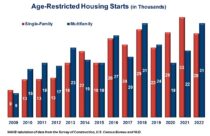Of the roughly 1,005,000 single-family and 547,000 multifamily homes started in 2022, 59,000 (28,000 single-family and 31,000 multifamily) were built in age-restricted communities, according to NAHB tabulation of data from the Survey of Construction (SOC, conducted by the U.S. Census Bureau and partially funded by HUD). A residential community can be legally age-restricted, provided it conforms the one of the set of rules specified in the Housing for Older Persons Act of 1995.

NAHB was first successful in persuading HUD and the Census Bureau to collect and publish data on the age-restricted status of new homes in 2009, during the depths of the housing downturn. In 2009, builders started only 17,000 homes in age-restricted communities (9,000 single-family and 8,000 multifamily). The numbers then increased steadily until reaching 60,000 age-restricted starts, roughly evenly split between single-family and multifamily) in 2018. In 2022, the 28,000 age-restricted single-family starts were slightly off the peak of 33,000 reached a year earlier, and the 31,000 age-restricted multifamily starts tied the all-time high set in 2018. Although we don’t yet have data on age-restricted starts for 2023, a recent post shows that starts in general have been running lower than they were a year earlier, due largely to the Federal Reserve’s policy of interest rate hikes to tame inflation.
The SOC provides enough data to look at the characteristics of new age-restricted single-family homes to see if they differ from other single-family homes started in 2022. This exercise shows that the age-restricted homes tend to be about the same size as others, but on somewhat smaller lots and higher-priced. The median size of an age-restricted home was exactly the same as the median for other single-family homes in 2022: 2,300 square feet. As usual, however, the median lot size for age-restricted homes, was somewhat smaller—just under one-sixth of an acre vs. one-fifth for homes started outside of age-restricted communities. There has been a general trend toward smaller lot sizes, as described in a September 8 post. Another trend that has continued is the one toward higher house prices. The median price of a new, age-restricted single family home started in 2022 and built for sale was $547,000—$75,000 higher than it was a year earlier and considerably above the $461,000 median price of non-age-restricted homes started in 2022.

Other questions in the SOC show that new single-family homes are more likely to be attached (i.e., townhomes), and single story with no basement if the homes are age-restricted. The age-restricted homes are also more likely to come with patios, but less likely to have decks. Finally, age-restricted homes are less likely to require a loan and more likely to be purchased for cash, as home buyers who are older have had more of a chance to accumulate the savings and assets (often equity in a previous home) that can be converted to cash.
Discover more from Eye On Housing
Subscribe to get the latest posts sent to your email.


Thank you for the article! 2 quick things
1. Where you say
“Another trend that has continued is the one toward higher house prices. The median price of a new, age-restricted single family home started in 2022 and built for sale was $472,000—$75,000 higher than it was a year earlier and considerably above the $461,000 median price of non-age-restricted homes started in 2022.”
In the chart, the $472k shows to be $547k. do you have typo in the sentence or am i reading this wrong?
2. In the chart it shows Price per SF of $180. When you take $547,000/2,300 sf = $237. Am i missing something here?
1. That was, in fact, a typo in the sentence. It should read $547,000 agreeing with the table. $472,000 was the median price in 2021. We have corrected the typo. Thank you for calling it to our attention.
2. Your calculation is dividing one median by another, an illegitimate mathematical operation that doesn’t yield a median or any other result with a meaningful interpretation. Below is a simple example of three homes with a median price of $537,000, a median size of 2,300 square ft, and a median price per square foot of $180.
House Price / Sq Ft / Price per Sq Ft
$250,000 / 2,000 / $125
$900,000 / 5,000 / $180
$547,000 / 2,300 / $238
Thank you! I was thinking averages! This was helpful 🙂
You’re entirely welcome. It’s always nice to communicate with Eye on Housing readers.
Potential homebuyers in this demographic might require tailored construction loans to accommodate these higher costs. Lenders need to adapt their loan offerings to match the evolving demands of such specialized housing markets, ensuring accessibility for interested buyers.